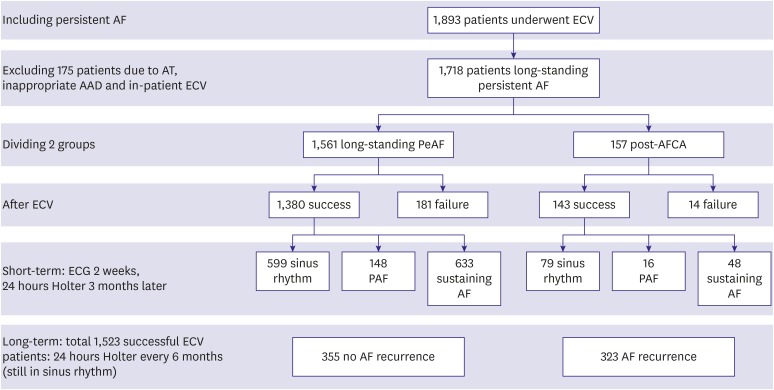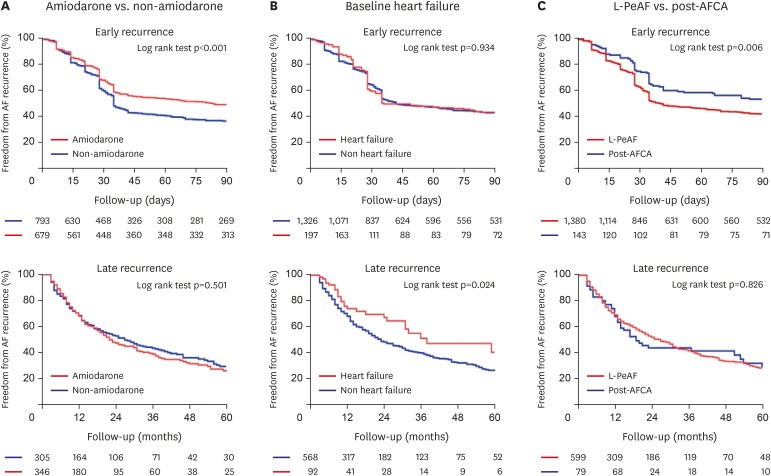Korean Circ J.
2020 Jun;50(6):511-523. 10.4070/kcj.2019.0310.
Efficacy and Safety of Outpatient Clinic-based Elective External Electrical Cardioversion in Patients with Atrial Fibrillation
- Affiliations
-
- 1Division of Cardiology, Department of Internal Medicine, Yonsei University Health System, Seoul, Korea
- KMID: 2500943
- DOI: http://doi.org/10.4070/kcj.2019.0310
Abstract
- Background and Objectives
Little is known about the outcomes of outpatient clinic-based elective external cardioversion (OPC-ECV) for persistent atrial fibrillation (PeAF). We investigated the acute, short-term, and long-term elective external cardioversion (ECV) outcomes.
Methods
We included 1,718 patients who underwent OPC-ECV (74% male, 61.1±11.0 years old, 90.9% long-standing PeAF, 9.1% after atrial fibrillation [AF] ablation) after excluding patients with atrial tachycardia or inappropriate antiarrhythmic drug medication, and in-patient ECV. Biphasic shocks were delivered sequentially until successful cardioversion was achieved (70-100-150-200-250 J). If ECV failed at 150 J, we administered intravenous amiodarone 150 mg and delivered 200 J.
Results
ECV failed in 11.4%, and the complication rate was 0.47%. Within 3 months, AF recurred in 55.5% (44.7% as sustaining AF, 10.8% as paroxysmal AF), and the AF duration was independently associated (odds ratio [OR], 1.01 [1.00–1.02]; p=0.006), but amiodarone was independently protective (OR, 0.46 [0.27–0.76]; p=0.002, Log rank p<0.001) against an early recurrence. Regarding the long-term recurrence, pre-ECV heart failure was protective against an AF recurrence (hazard ratio, 0.63 [0.41–0.96], p=0.033) over 32 (9–66) months of follow-up. ECV energy (p<0.001) and early recurrence rate within 3 months (p=0.007, Log rank p=0.006) were significantly lower in post-ablation patients than in those with long-standing persistent AF.
Conclusions
The success rate of OPC-ECV was 88.6%, and the complication rate was low. However, AF recurred in 55.5% within 3 months. Amiodarone was protective against short-term AF recurrences, and long-term AF recurrences were less in patients with baseline heart failure.
Keyword
Figure
Cited by 3 articles
-
External Electrical Cardioversion is an Easy and Safe Intervention for Rhythm Control in Persistent Atrial Fibrillation
Chang Hee Kwon
Korean Circ J. 2020;50(6):524-526. doi: 10.4070/kcj.2020.0122.The Impact of Right Atrial Size to Predict Success of Direct Current Cardioversion in Patients With Persistent Atrial Fibrillation
Christoph Döring, Utz Richter, Stefan Ulbrich, Carsten Wunderlich, Micaela Ebert, Sergio Richter, Axel Linke, Krunoslav Michael Sveric
Korean Circ J. 2023;53(5):331-343. doi: 10.4070/kcj.2022.0291.Is Right Atrial Remodeling an Additional Marker for the Progression of Atrial Fibrillation?
Jin-Kyu Park
Korean Circ J. 2023;53(5):344-346. doi: 10.4070/kcj.2023.0069.
Reference
-
1. Kim D, Yang PS, Jang E, et al. 10-year nationwide trends of the incidence, prevalence, and adverse outcomes of non-valvular atrial fibrillation nationwide health insurance data covering the entire Korean population. Am Heart J. 2018; 202:20–26. PMID: 29802976.
Article2. Marrouche NF, Brachmann J, Andresen D, et al. Catheter ablation for atrial fibrillation with heart failure. N Engl J Med. 2018; 378:417–427. PMID: 29385358.
Article3. Packer DL, Mark DB, Robb RA, et al. Effect of catheter ablation vs antiarrhythmic drug therapy on mortality, stroke, bleeding, and cardiac arrest among patients with atrial fibrillation: the CABANA randomized clinical trial. JAMA. 2019; 321:1261–1274. PMID: 30874766.4. Mansour M, Heist EK, Agarwal R, et al. Stroke and cardiovascular events after ablation or antiarrhythmic drugs for treatment of patients with atrial fibrillation. Am J Cardiol. 2018; 121:1192–1199. PMID: 29571722.
Article5. Jin MN, Kim TH, Kang KW, et al. Atrial fibrillation catheter ablation improves 1-year follow-up cognitive function, especially in patients with impaired cognitive function. Circ Arrhythm Electrophysiol. 2019; 12:e007197. PMID: 31442075.
Article6. Park JW, Yu HT, Kim TH, et al. Atrial fibrillation catheter ablation increases the left atrial pressure. Circ Arrhythm Electrophysiol. 2019; 12:e007073. PMID: 30917688.
Article7. Ecker V, Knoery C, Rushworth G, et al. A review of factors associated with maintenance of sinus rhythm after elective electrical cardioversion for atrial fibrillation. Clin Cardiol. 2018; 41:862–870. PMID: 29878481.
Article8. Hellman T, Kiviniemi T, Nuotio I, et al. Optimal timing for cardioversion in patients with atrial fibrillation. Clin Cardiol. 2018; 41:966–971. PMID: 29802625.
Article9. Joglar JA, Kowal RC. Electrical cardioversion of atrial fibrillation. Cardiol Clin. 2004; 22:101–111. PMID: 14994851.
Article10. Frick M, Frykman V, Jensen-Urstad M, Ostergren J. Factors predicting success rate and recurrence of atrial fibrillation after first electrical cardioversion in patients with persistent atrial fibrillation. Clin Cardiol. 2001; 24:238–244. PMID: 11288971.
Article11. Nakazawa H, Lythall DA, Noh J, et al. Is there a place for the late cardioversion of atrial fibrillation? A long-term follow-up study of patients with post-thyrotoxic atrial fibrillation. Eur Heart J. 2000; 21:327–333. PMID: 10653681.
Article12. Botkin SB, Dhanekula LS, Olshansky B. Outpatient cardioversion of atrial arrhythmias: efficacy, safety, and costs. Am Heart J. 2003; 145:233–238. PMID: 12595839.
Article13. Grönefeld G, Ehrlich JH, Hohnloser S. Comparison of outpatient vs inpatient direct current cardioversion of atrial fibrillation: Safety, efficacy and cost savings. Eur Heart J Suppl. 2003; 5:H19–24.14. January CT, Wann LS, Alpert JS, et al. 2014 AHA/ACC/HRS guideline for the management of patients with atrial fibrillation: a report of the American College of Cardiology/American Heart Association Task Force on Practice Guidelines and the Heart Rhythm Society. J Am Coll Cardiol. 2014; 64:e1–76. PMID: 24685669.15. Lang RM, Badano LP, Mor-Avi V, et al. Recommendations for cardiac chamber quantification by echocardiography in adults: an update from the American Society of Echocardiography and the European Association of Cardiovascular Imaging. Eur Heart J Cardiovasc Imaging. 2015; 16:233–270. PMID: 25712077.
Article16. Kim SS, Knight BP. Electrical and pharmacologic cardioversion for atrial fibrillation. Cardiol Clin. 2009; 27:95–107. PMID: 19111767.
Article17. Ponikowski P, Voors AA, Anker SD, et al. 2016 ESC Guidelines for the diagnosis and treatment of acute and chronic heart failure: The Task Force for the diagnosis and treatment of acute and chronic heart failure of the European Society of Cardiology (ESC)Developed with the special contribution of the Heart Failure Association (HFA) of the ESC. Eur Heart J. 2016; 37:2129–2200. PMID: 27206819.18. Pisters R, Nieuwlaat R, Prins MH, et al. Clinical correlates of immediate success and outcome at 1-year follow-up of real-world cardioversion of atrial fibrillation: the Euro Heart Survey. Europace. 2012; 14:666–674. PMID: 22223715.
Article19. Roy D, Talajic M, Dorian P, et al. Amiodarone to prevent recurrence of atrial fibrillation. N Engl J Med. 2000; 342:913–920. PMID: 10738049.
Article20. Singh BN, Singh SN, Reda DJ, et al. Amiodarone versus sotalol for atrial fibrillation. N Engl J Med. 2005; 352:1861–1872. PMID: 15872201.
Article21. Hwang ES, Nam GB, Joung B, et al. Significant reduction of atrial defibrillation threshold and inducibility by catheter ablation of atrial fibrillation. Pacing Clin Electrophysiol. 2012; 35:1428–1435. PMID: 22978799.
Article22. Inoue K, Kurotobi T, Kimura R, et al. Trigger-based mechanism of the persistence of atrial fibrillation and its impact on the efficacy of catheter ablation. Circ Arrhythm Electrophysiol. 2012; 5:295–301. PMID: 22042883.
Article23. Chen PS, Chen LS, Fishbein MC, Lin SF, Nattel S. Role of the autonomic nervous system in atrial fibrillation: pathophysiology and therapy. Circ Res. 2014; 114:1500–1515. PMID: 24763467.24. Spinale FG, Tomita M, Zellner JL, Cook JC, Crawford FA, Zile MR. Collagen remodeling and changes in LV function during development and recovery from supraventricular tachycardia. Am J Physiol. 1991; 261:H308–18. PMID: 1877659.
Article25. Ling LH, Kistler PM, Kalman JM, Schilling RJ, Hunter RJ. Comorbidity of atrial fibrillation and heart failure. Nat Rev Cardiol. 2016; 13:131–147. PMID: 26658575.
Article26. Dries DL, Exner DV, Gersh BJ, Domanski MJ, Waclawiw MA, Stevenson LW. Atrial fibrillation is associated with an increased risk for mortality and heart failure progression in patients with asymptomatic and symptomatic left ventricular systolic dysfunction: a retrospective analysis of the SOLVD trials. Studies of Left Ventricular Dysfunction. J Am Coll Cardiol. 1998; 32:695–703. PMID: 9741514.27. Ling LH, Khammy O, Byrne M, et al. Irregular rhythm adversely influences calcium handling in ventricular myocardium: implications for the interaction between heart failure and atrial fibrillation. Circ Heart Fail. 2012; 5:786–793. PMID: 23014130.28. Ling LH, Taylor AJ, Ellims AH, et al. Sinus rhythm restores ventricular function in patients with cardiomyopathy and no late gadolinium enhancement on cardiac magnetic resonance imaging who undergo catheter ablation for atrial fibrillation. Heart Rhythm. 2013; 10:1334–1339. PMID: 23811081.
Article
- Full Text Links
- Actions
-
Cited
- CITED
-
- Close
- Share
- Similar articles
-
- The Influence of Electrical Cardioversion for Atrial Fibrillation on Left Atrial Appendage Function: A Transesophageal Echocardiography Study
- A Case of Successful Ablation of Right-Sided Accessory Pathway during Atrial Fibrillation
- Electrical Cardioversion of Atrial Fibrillation after Successful Percutaneous Balloon Mitral Valvuloplasty
- Use of NOAC in Cardioversion
- Atrial Fibrillation in a Patient with Left Ventricular Hypertrophy after Induction of General Anesthesia: A case report



